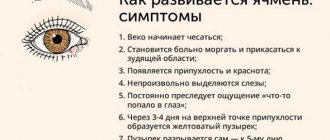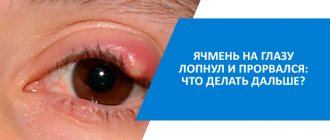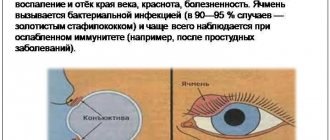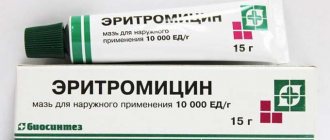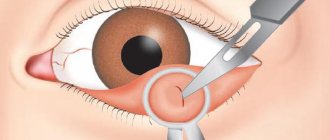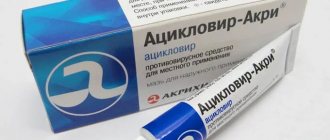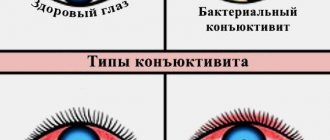What is stye on the eye?
Barley on the eye is a disease of the eyelid, in which acute purulent inflammation of the hair follicle of the eyelash occurs, involving the nearby sebaceous gland. If a lobule of the meibomian gland (a modified sebaceous gland, the duct of which opens into the edge of the eyelid) is involved in the process, the disease is called internal barley because the purulent process develops on the inner surface of the eyelid.
Stye on the eye is very common - according to statistics, more than 20% of the world's population suffers from it.
The main reason is a bacterial infection, specifically Staphylococcus aureus - 95% of cases of stye on the eye. Predisposing factors: hypothermia, immunity deficiency, hypovitaminosis, furunculosis, blepharitis, demodicosis, chronic diseases (diabetes mellitus, gastritis, peptic ulcer, colitis, dysbacteriosis, etc. The key risk factors for stye in a child are hypothermia and diseases of the gastrointestinal tract.
Stye on the eye looks typical - an abscess on the eyelid that forms within 2-5 days. Patients feel a dull pain, swelling in the area of the affected eyelid, a local increase in temperature, and general weakness.
Barley is diagnosed by a family doctor, pediatrician, general practitioner, or ophthalmologist based on the characteristic appearance of the abscess. Internal stye is diagnosed by an ophthalmologist.
In most cases, barley goes away on its own within 5-7 days. Treatment of barley is carried out at home, with the exception of complications - the spread of infection to the eye socket and membranes of the brain. To alleviate the disease at the stage of barley ripening, the eyelid is treated with calendula tincture, ethyl alcohol, iodine, and brilliant green. Use eye ointments and drops with an antibiotic (Floxal), ointment with hydrocortisone, etc.
Drops and ointments treat stye on the eye relatively quickly - within 5 days. However, you should know that it is not possible to cure stye on the eye in one day.
Among the physiotherapeutic methods of treatment in order to accelerate the ripening of barley, UHF is indicated. Thermal procedures, incl. Most experts do not recommend warming compresses for fear of provoking an abscess, phlegmon of the orbit with the spread of infection to the meninges (meningitis).
Prevention of barley comes down to strengthening the immune system, vitamin therapy in the fall and spring, a healthy lifestyle, and timely treatment of chronic diseases.
Boil on a child's eye
Boil or barley is an infectious and inflammatory disease that forms in the hair follicles of the eyelashes and eyebrows.
Pathology manifests itself as a result of the inflammatory process and an increase in the amount of pathogenic microflora in this area. The disease is accompanied by swelling, redness, and pain. A professional consultation with an ophthalmologist is recommended, who will prescribe the correct treatment after diagnostic procedures.
We recommend reading: Furuncle on the eye
Causes of a boil on the eye
The main reasons for the appearance of infectious and inflammatory conditions in the hair follicles are:
- the formation of microtraumas and small wounds into which infection penetrates;
- violation of hygiene rules, which leads to the gradual accumulation of pathogenic microorganisms;
- non-compliance with the rules for using contact lenses (dirty container, use of cleaning fluid several times in a row);
- infectious and inflammatory diseases in neighboring tissues or organs (bacterial conjunctivitis, sinusitis, tonsillitis);
- touching the eyes with dirty hands, especially after children play in the sandbox;
- contact with the eyes of a foreign object (specks, dust, fragments);
- systemic diseases;
- bacilli carriage (increased content of staphylococcal and streptococcal microflora);
- violation of the secretion of sebaceous glands;
- the formation of allergic reactions that are complicated by bacterial infection;
- frequent contact with chemicals and dust.
To completely eliminate the disease and eliminate the risk of its recurrence, the doctor needs to identify the root cause of the disease.
Types of boils
Depending on the stage of development, boils are divided into several categories:
- the onset of the inflammatory process, which manifests itself as slight redness in the affected area;
- acute inflammatory process with the formation of a large amount of pus under the skin;
- full maturation, when the pus is located close to the surface of the skin;
- skin damage and pus coming out.
Based on the number of formations, the disease is divided into several groups:
- single formation, localized only at one point;
- the appearance of multiple boils along the hairline.
Depending on the location of the purulent discharge, boils are divided into several types:
- superficial, when purulent discharge is localized only in the hair follicle;
- deep, characterized by decay of the deep layers of the skin.
In the medical history, the doctor describes the type of boil and subsequent treatment.
Early symptoms
When the inflammatory process in the area of the hair follicles has just begun to form, the disease is characterized by the following clinical symptoms:
- redness in the affected area;
- compaction on the skin;
- slight tissue swelling;
- sensation of a foreign body under the eyelids;
- itching, burning, pain in the affected area;
- redness of the eyes;
- increased production of tear fluid.
After passing the initial stage, compaction begins in the lesion. This means that pus has been released in large quantities and has accumulated under the skin.
Treatment
To receive treatment, you must consult with your doctor. Opening a boil on your own is unacceptable; it will lead to the formation of an additional infection that will spread to deeper tissues. The risk of severe tissue damage increases. Complex therapy is used aimed at eliminating the formation and preventing the possibility of its recurrence.
Medications
Since the boil is caused by the proliferation of a bacterial infection, the following drugs are used:
Drugs that help accelerate the maturation of formation are also indicated:
- heparin ointment (attracts pus to the skin);
- Vishnevsky ointment (has an anti-inflammatory, antibacterial effect, helps improve the immune response) promotes rapid breakthrough of boils and further tissue healing.
Surgical procedures
This method is indicated when the boil remains in front of the patient for an excessively long time. It can only be performed by an ophthalmologist or surgeon. It is prohibited to remove the boil yourself, as this will lead to the spread of infection and tissue damage.
The doctor uses a scalpel, with which he makes an incision at the top of the boil, removes its contents, and applies an antibacterial drug.
To accelerate tissue healing after surgical removal of a boil, the doctor may prescribe drugs that promote accelerated regeneration, for example, Solcoseryl.
To reduce inflammatory reactions, use anti-inflammatory drops. It is necessary to strictly adhere to the surgeon’s instructions after removing the pus.
Traditional methods
This method of treatment is used only in addition to drug therapy. They use various decoctions of herbal remedies, which are poured with boiling water and cooled to room temperature. Chamomile, calendula, and coltsfoot are suitable for these purposes. All these plants have anti-inflammatory and antibacterial effects.
Complications
If left untreated, the patient may experience the following complications after the formation of a boil:
- penetration of pus into the deep layers of the skin;
- an increase in the number of boils on the eyelids and eyebrows;
- spread of the infectious-inflammatory process to the conjunctiva, cornea, lacrimal sac;
- severe swelling of the eyelids, when the eyeball is practically invisible;
- chronic infectious and inflammatory diseases in the hair follicles of the eyelashes and other areas of the eyes.
To prevent complications, it is recommended to begin therapy immediately after swelling and slight redness appear on the eyelids.
Prevention
To prevent the formation of barley, it is recommended to adhere to the following rules:
- daily hygiene procedures for the eyes and entire face;
- timely treatment of ophthalmological and systemic diseases;
- antibiotic therapy only as prescribed and no more than the course prescribed by the doctor (5-7 days);
- use of contact lenses according to all rules;
- frequent hand washing;
- timely antihistamine therapy for allergic diseases.
The use of preventive measures will not completely eliminate the possibility of barley formation. Their use will significantly reduce the risk of its manifestation. Boils are a fairly common occurrence in medicine. The prognosis for the patient's condition is favorable if treatment is started in a timely manner.
During the formation of pathology, it is strictly prohibited to independently extract the contents before the skin breaks through. At home, doctors recommend the use of antibacterial therapy, but not more than 7 days.
Was the article helpful?
Rate the material on a five-point scale!
( 1 5.00
Source: https://proglazki.ru/bolezni/chirej-na-glazu-u-rebenka/
Causes of stye on the eye
Stye on the eye occurs due to a bacterial infection - in the vast majority of cases under the influence of Staphylococcus aureus. Bacteria are always present on the skin of the eyelid. Under the influence of pathological factors, bacteria penetrate the eyelash bulb and begin to actively multiply.
Here are the pathological factors that provoke stye on the eye:
- hypothermia;
- weakened immune system;
- hypovitaminosis;
- diseases of the eyelid, in particular blepharitis; demodicosis;
- furunculosis, streptoderma;
- chronic diseases: diabetes mellitus, gastritis, peptic ulcer, colitis, dysbacteriosis, etc.;
- failure to comply with personal hygiene rules.
Causes
According to Evgeny Komarovsky, in the vast majority of cases (more than 99.9% probability), such inflammation is caused by a microbe called Staphylococcus aureus. This is a very resistant microbe to antibiotics and aggressive external influences, which always causes inflammation of a purulent nature.
The microbe spreads through friction of the affected area, which is why some children develop several styes one after another in one eye.
It is impossible to avoid contact with this bacterium; Staphylococcus aureus lives almost everywhere. However, in one child it causes a stye when it gets into the eye area, and in another it does not. Here, according to Dr. Komarovsky, an additional factor plays a role - the state of the child’s immunity. If the immune defense is weakened by a recent illness, the likelihood of developing hordeolum increases.
Komarovsky considers disruption of the sweat glands to be another “auxiliary” reason for the appearance of styes. Therefore, the doctor advises you to pay special attention to whether you are overheating your child or whether he is sweating.
Symptoms of stye on the eye in an adult and a child
Barley on the eye appears in the form of a characteristic, clearly visible abscess on the outer surface of the eyelid. With internal barley, an abscess forms on the inner surface of the eyelid.
An abscess on the eyelid matures within 2-5 days, after which it goes away on its own in 95% of cases. Ripe stye leads to a sharp swelling of the eyelid due to which the eye on the affected side is partially covered. Patients complain of dull pain, heaviness and swelling in the area of the affected eyelid, local fever, and general weakness.
Barley on the eye of a child has the same clinical manifestations as in an adult; at the same time, children first become restless, then lethargic.
About the disease
Hordeolum, which is the medical name for what is popularly called “stye,” is an acute inflammation of a purulent nature. It affects the hair follicle or sebaceous gland of Zeiss, located in close proximity to the eyelash bulb.
If the inflammation occurs on the outer part of the eyelid, then they talk about hordeolum, if on the inner side of the eyelid, doctors diagnose internal stye. When it occurs, the so-called meibomian gland becomes inflamed.
In both cases, the child’s eyelid swells, redness and severe pain appear. On the 2-3rd day, the barley acquires a yellow “head” filled with pus; later it breaks through, the purulent contents come out, the pain disappears, and the swelling gradually subsides.
Sometimes these classic symptoms are supplemented by redness of the mucous membrane of the eye, increased body temperature, and enlarged lymph nodes (usually behind the ear, occipital, submandibular).
With internal barley (meibomitis), the inflammatory process is not so acute, the pain is not so strong. The abscess, when the time comes, opens not outside, but inside the conjunctival sac.
Most often, according to the observations of ophthalmologists, stye appears on the upper eyelid. If the boil occurs on the lower eyelid, it usually hurts more.
In young children, the course of the infection is always more pronounced than in adolescents. When barley occurs, a one-year-old child often experiences an increase in temperature, sometimes even the appearance of symptoms of general intoxication.
In children aged 2-3 years, barley occurs more easily. With a boil on the eye of a teenager, it is often possible to do without treatment, since the abscess ripens quite quickly and opens on its own.
Treatment of stye on the eye
Since barley on the eye almost always goes away on its own, treatment comes down to accelerating the maturation of the abscess, reducing unpleasant subjective sensations and preventing complications - the spread of infection to the orbit and to the membranes of the brain with the development of meningitis. Treatment of stye on the eye is carried out at home. Complications of stye are treated in a hospital.
At the stage of maturation of the abscess, the eyelid is treated with tincture of calendula, iodine, brilliant green, and ethyl alcohol.
To accelerate maturation, UHF is used (if there is no general increase in body temperature).
To date, there is no consensus on the effectiveness of local heat treatment and warm compresses, but most ophthalmologists have recently not recommended them, preferring local antibacterial drops and ointments, as well as hydrocortisone ointment.
We strongly do not recommend local thermal procedures and warming compresses for barley on a child’s eye.
Of the local antibacterial drugs, Floxal (ointment and drops) containing the antibiotic Ofloxacin, Levomekol ointment (containing the antibacterial drug Levomycetin) are most often used. Drops are used for concomitant conjunctivitis - drops in the eye 3 times a day. The ointment is also applied to the affected eyelid 3 times a day. The duration of treatment is 5 days, regardless of symptoms.
Strengthening the body with the help of immunomodulators (Lymphomyosot, Echinacea, etc.) and adaptogens (ginseng root, Eleutherococcus, etc.), and multivitamins is indicated.
Stye on a child’s eye: how to treat and what to do
Many parents are quite frivolous about such a problem as stye on a child’s eye. Meanwhile, this disease brings a lot of inconvenience and discomfort to the baby. It is important to notice the disease in time and take all necessary measures so that long-term treatment is not required.
Below we will look at the main causes of boils in the eyes and tell you how to treat them and what preventive measures will help avoid them in the future. The famous children's doctor E. O. Komarovsky says that the initial cause of barley is Staphylococcus aureus.
This microbe is very common and can easily enter the body through unwashed hands, vegetables, fruits, toys and other household items. But in order for him to begin his active work, “favorable” conditions are necessary.
Hypothermia, poor hygiene, weak immunity suffered on the eve of an infectious disease can contribute to the appearance of barley. There are also cases when an internal stye forms on the eye. In this case, you will not see the purulent head. Outwardly, only red inflammation and swelling will be noticeable.
If your child has such an internal stye, then most likely it is an inflammation of the meibovian glands. At the very beginning, a stye in a child causes burning and itching in a certain area of the eye. Often it is the ciliary edge of the eyelid that itches. Also in children there is significant redness of the eyelid and after a few hours it is accompanied by swelling.
In addition, children's lymph nodes become enlarged. A few days after the itching and burning, a purulent head appears. After this, the stye looks like a small ball. In complex and advanced forms, the stye can become so inflamed that the child will not be able to see with the affected eye due to swelling. A headache may also occur.
Normally, the pus begins to come out on its own after 3-4 days and the inflammation goes away. Sometimes the contents of the eye chir remains inside and passes without a trace without a breakthrough. This result can be achieved with timely treatment with ointment or drops. As for consulting a doctor, it will not hurt in any case.
It should promote rapid recovery and relieve associated symptoms: itching, pain, burning, swelling. Most often, local treatment is used using ointments and drops. Since the main causative agent of barley is Staphylococcus aureus, it can be treated with antibacterial ointments. Quite often, doctors prescribe 1% tetracycline eye ointment.
It should be applied directly to the sore eyelid and abscess. To apply the ointment hygienically, use sterile cotton swabs and wash your hands thoroughly. However, remember that you cannot use them twice; you need to take out a new cotton swab for each use. There is also erythromycin ointment.
They all have the same bactericidal effect, but differ in the active substance. On average, the ointment should be used 2-3 times a day. But such drugs must be prescribed by doctors, since they contain antibiotics. Especially such ointments should not be used in the treatment of children under one year old. Infants under one year of age are prescribed eye drops.
It is prohibited to independently select medications for such children, especially those with antibacterial effects. Albucid or Ciprofloxacin drops are used to treat eye styes. Drops give no less better results than ointments. They are used 4-5 times a day depending on the doctor's instructions.
Drops should be instilled into both eyes at once, even if the second visual organ is not infected. Since the drops affect the mucous membrane of the eyes, they can cause a burning sensation. If a child’s barley appears constantly from year to year with the slightest decrease in immunity, and in addition boils form on the body, then it’s time to think about complex treatment of staphylococcal infection.
So says Dr. E. O. Komarovsky. In this case, he recommends that you contact your treating pediatrician so that he can prescribe a course of treatment with internal antibiotics, because drops and ointments alone are unlikely to help. At the same time, Dr. E. O. Komarovsky is quite skeptical about traditional methods that help treat stye. Although there are many similar methods.
In the first days of the disease, when the child’s eye itches and hurts, you can apply cold compresses. It is suggested that a cold compress be made from a herbal infusion. It is best to use several medicinal herbs: calendula, chamomile, St. John's wort. It should be noted that a cold compress can only be used for minor inflammation.
You can effectively treat barley in a child using lotions with fresh aloe juice. The medicinal solution should be made in a 1:1 ratio with boiled water. To relieve severe itching, it is recommended to make compresses with a solution of baking soda. Before treating children under 1 year of age with traditional methods, be sure to consult a doctor. Any disease is easier to prevent than to treat.
It is important for parents to carefully monitor the health of their child throughout the year and do everything possible to ensure that their immune system works effectively. Personal hygiene plays an important role. The child should always have clean hands so that he does not introduce an infection into his eyes, which can subsequently provoke the appearance of chiria.
Children should also eat a balanced diet and receive the full range of vitamins and minerals. If you know that your baby is prone to infectious diseases, carry out preventive therapy every year during the season of mass influenza and acute respiratory viral infections. You can give your child prophylactic antiviral drops to boost immunity. They should be prescribed by a pediatrician. Don't forget to do frequent wet cleaning and ventilation in the children's room.
A source of information.
Leave your comment...
Source: https://emclinic.com.ua/2030-yachmen-na-glazu-u-rebenka-kak-lechit-i-chto-predprinyat.html
Prevention of stye on the eye
To avoid barley and prevent the appearance of repeated ulcers, follow the recommendations:
- observe the rules of personal hygiene;
- do not get too cold;
- promptly treat diseases of the eyelid: blepharitis, demodicosis, etc.; chronic diseases: diabetes, gastritis, peptic ulcer, colitis, dysbacteriosis, etc.; dermatitis, abscess, boil, streptoderma;
- strengthen your immune system, take multivitamins in spring and autumn;
- lead a healthy lifestyle.
Reasons for appearance
It is impossible to become infected with barley, but it can form again, even in the shortest possible time. This may happen because the baby’s body was unable to resist microbes, that is, his immunity was weak.
Stye appears on the upper and lower eyelids for one reason. But on the upper eyelid it can be not only external, but also internal, maturing inside the eyelid. In this case, it is formed in one day. With barley below, part of the face swells, swells, and the inflamed area turns red.
Barley often appears when the simplest hygiene rules are not followed:
- The child rubbed his eyes with unwashed hands and caused an infection;
- A speck got into the eye and caused a stye, especially if they tried to get it out with a dirty handkerchief;
- Dust gets into the eye, this often happens on the street, especially in windy weather;
- The infection could have ended up on someone else's towel or handkerchief, which the child could have used;
- Hypothermia could also be the cause of barley.
However, parents should be aware that barley can also appear as a consequence of serious diseases .
- Barley may indicate that the baby has low immunity, especially if the child has recently been ill and has not yet recovered from the illness.
- Most likely the child has stomach or intestinal problems.
- Perhaps diabetes is beginning to develop.
- The cause can also be common worms.
- Insufficient amount of vitamins.
- There may also be a hereditary predisposition.
Symptoms of the disease
Basically, the appearance of barley is accompanied by the following symptoms:
- The eyelid swells, swelling appears, the eye opens poorly;
- Itching begins;
- The temperature rises (in rare cases);
- Your head may hurt;
- Two days after the first symptoms appear, a yellowish tubercle is noticeable on the eyelid, which can break out at any time;
- The eye hurts, turns red and watery, it often hurts to blink;
- Lymph nodes may be enlarged.
General recommendations for treatment
How to cure barley in a child? Barley is an inflammatory process and is treated conservatively.
When inflammation has begun and there is no abscess formation yet, the stye can be cauterized with iodine, brilliant green, medical alcohol (do this with extreme caution so as not to damage the mucous membrane of the eyes).
The doctor may prescribe an UHF procedure. Ultraviolet light kills infection, and the infrared part of the spectrum helps accelerate ripening. By the way, the sun has the same effect. When an abscess begins to form, compresses should be stopped.
A warm compress (hot water bottle) helps a lot; it helps accelerate the maturation of ulcers. If you repeat the procedure regularly, morning and evening for 15-20 minutes, then in about two days the stye will open.
How to treat barley in a child
Drops for the treatment of barley
If treatment at an early stage does not help, then it is necessary to begin instilling albucid . In this case, the barley bacteria will be destroyed by the substance sulfacetamide, which is contained in albucid.
Drops containing antibiotics are widely used for the same purpose. This can be penicillin and erythromycin in solutions; if a child is allergic to penicillin, the doctor will most likely recommend replacing it with gentamicin.
Levomycetin drops are used - this is an antimicrobial agent that is used in many cases. There are also new generation antibiotics - Tobrex and Tsiprolet, they act on the basis of the substance tobramycin.
The doctor decides which drug and in what dosage can be used. This is very individual and depends on many factors:
- From the causes of barley;
- Child's age;
- General condition of the body.
During this period, the child needs to take vitamins C and A , they help restore the skin after barley.
Ointments for treatment
Ointments are less common than drops. They are more difficult to use, especially for a child. But they are no less effective; they also contain antibiotics. Ointments commonly used :
- Tetracycline;
- Erythromycin;
- Hydrocortisone;
- Levomekolevaya.
They are placed under the eyelid. It is better to apply tetracycline ointment at night, as it melts and spreads over the eyelid, causing blurred vision. The ointment does not spread for a long time, but it definitely gets to the site of inflammation. There is also a minus - a thick concentration. But now they produce antibacterial gels, for example, blefarogel.
Folk remedies
There are folk remedies that traditional medicine does not refuse. These are all kinds of lotions from herbal decoctions:
- Steam 10 grams of chamomile, 10 grams of calendula flowers and boil for 10 minutes. Infuse and use as a warm lotion.
- Squeeze the juice from an aloe leaf, dilute with very warm water in a ratio of one to ten, and apply a lotion to the eye area.
- Dilute a teaspoon of aloe juice in a quarter glass of boiled water at room temperature, put a bandage there, squeeze and apply constantly overnight.
- Boil the flaxseed, squeeze it out, pack it warm in a gauze bag and apply it to the eye.
- You can take drunk tea as a lotion. Even a simple used tea bag will do the job.
- Pour two tablespoons of tea and the same amount of dry crushed St. John's wort herb, brew, let it brew for 15 minutes and make compresses.
- Lotion from a decoction of calendula flowers: 10 grams of flowers per 200 grams of water.
There are also somewhat strange folk methods of treating this disease. It happens that they also cure, under one condition: you have to believe in them, then the placebo effect will work.
- You have to spit in the sore eye (a very commonly used “method”).
- Barley will go away if you show the fig to the growing month.
- You need to tie a thread on your finger, on the opposite side of the sore eye. Keep pulling the thread.
- Apply the ring around the eye.
- Take a small pellet of sulfur and tie it in woolen fabric, thread it through the lace and put it on the child’s chest.
- Wrap a woolen thread, always red, around the wrist on the hand opposite the sore eye.
- Look into the dark glass bottle several times.
Stye in a child - Komarovsky: what to do and how to treat it on the eye, treatment
Inflammation of the hair follicle of the eyelash or the sebaceous gland of Zeiss, occurring in an acute form and with the accumulation of purulent exudate, in medicine is called hordelium, otherwise barley.
The pathology is widespread among people of all ages, incl. children. In addition to banal eye contamination, this condition can be provoked by serious disorders of internal organs.
Why does it appear
The causative agent of the inflammatory process is Staphylococcus aureus. This bacterium lives on the skin and hair of every person, but becomes dangerous only under favorable conditions. The main reason for the development of a purulent infection in the eye is a weakening of the body's protective function.
This condition is provoked by:
- hypothermia of the body;
- previous diseases of a viral or bacterial nature;
- avitaminosis;
- changes in hormonal levels (in adolescents, the endocrine system is reconstructed, which is why sweat becomes more viscous and clogs the jelly ducts);
- inflammatory diseases occurring in a chronic form;
- worms;
- disorders of the intestines and/or stomach.
In children, barley is observed several times more often than in adult patients. This is often due to the child’s violation of personal hygiene rules (wiping his eyes with dirty hands or a stale towel).
To avoid wasting valuable time, find out the symptoms of retinal cancer here.
Worms can cause frequent stye in a child.
Let's make life easier - learn about the causes and treatment of pain in the eyes from the article.
Main symptoms
In children, gordelium can be observed in one or two eyes, on the upper or lower eyelid at the same time. On the upper eyelid, stye develops externally or internally, this process takes no more than 1-2 days, on the lower eyelid – 2-4 days. An abscess located below leads to:
- mild swelling of the face and eyelids;
- noticeable redness of the inflamed area;
- headache;
- difficulty opening the eye;
- itching;
- tremor of the eyelid (not always);
- increased blinking;
- lacrimation (not always).
On the 2nd day after the first signs of inflammation appear on the eyelid, a small yellow or pale yellow bump appears on the eyelid. After another day it opens itself. If this does not happen, the surgeon hides the boil.
If, along with the indicated symptoms, the child develops fever and weakness, he is hospitalized.
An effective medication for the treatment of bacterial infections in ophthalmology - instructions for Fucithalmic eye drops.
Headache can become a concomitant symptom during the development of the disease
When the prescription of Hilabak eye drops is indicated, read here.
How to cure
Traditional medicine offers a lot of “non-medicinal” ways to combat purulent inflammation of the eye. The simplest of them are a “cookie” pushed as far as possible to the site of the lesion, spitting in a sore eye, or a red thread wound around the fingers.
Naturally, this is an example of how it is not necessary to treat gordelium, because inflammation cannot be eliminated with such means. As a last resort, ophthalmologists and pediatricians suggest combining grandma's recipes with traditional medicines.
Barley in a child is treated conservatively. Before an abscess forms, the swollen area is carefully cauterized with a solution of brilliant green or iodine, being careful not to burn the mucous membrane. A good remedy for stye on the eye is warm compresses.
Your doctor may also recommend UHF treatments or stye eye drops based on albucid, penicillin, tobramycin, or erythromycin. Instillations in all cases are carried out into the conjunctival sac. The dosage is calculated individually for each small patient, taking into account the cause that led to inflammation, the age of the child and other factors.
Stye ointment (also based on antibiotics) is placed under the eyelid at night.
A broad-spectrum antibiotic from the aminoglycoside group - instructions for Tobropt eye drops.
Conspiracies can be used as a kind of psychotherapy, but not instead of the main treatment
Why daily eye tonometry is performed, find out at the link.
Doctor Komarovsky's opinion
Well-known children's pediatrician Dr. Evgeny Komarovsky divides the duration of treatment of the inflammatory process depending on the associated factors. If barley:
- Appears often (and also if there are several gordeliums) - local therapy is not enough, oral antibiotics are required.
- It appears rarely - you should not resort to antibiotics, giving the baby’s immune system the opportunity to cope with the pathology on its own.
- It is large in size and causes severe pain - instillations of 20-30% sodium sulfacyl or 1% hydrocortisone emulsion are required.
- Does not open on its own within 1 week from the moment of manifestation - surgical intervention is required.
Dr. Komarovsky does not recommend steaming or heating the boil, and emphasizes that such a condition can be cured, even taking into account a course of antibiotics, in at least 2 weeks.
To prevent staphylococcal infection from spreading to the orbit (provoking meningitis or phlegmon of the orbit), the abscess must not be squeezed out or opened independently.
An effective antiglaucoma drug is Travatan eye drops.
Dr. Komarovsky recommends combining antibacterial drops and ointments as recommended by a doctor
How to recognize the onset of central retinal vein thrombosis is described in detail in the article.
Preventive actions
Prevention consists primarily of following the rules of hygiene:
- There should be a handkerchief in your pocket, preferably a disposable one;
- It is necessary to teach the child not to use other people’s hygiene products;
- Do not rub your eyes, especially with dirty hands.
To prevent barley you need:
- Identify chronic diseases in a timely manner;
- Timely eliminate sources of infection and inflammatory processes;
- Temper the child;
- Spend more time outdoors;
- Organize nutritious meals;
- Increase his immunity;
- Prevent worms;
- Teach your child to wash his face with baby or cosmetic soap in the morning to degrease the edges of the eyelids.
Parents should take the treatment of stye in their child seriously. Try to take all measures at an early stage. Do not treat yourself, consult a doctor. And most importantly, constantly engage in prevention , especially since the above preventive measures help to avoid many diseases, not just barley.
What to do if barley appears in a child?
Some parents, at the sight of their baby’s inflamed eye, begin to panic and look for all kinds of remedies, including antibiotics.
Some, on the contrary, considering barley a trivial disease, let everything take its course. They hope for a quick self-healing from the purulent formation.
It is not always possible to obtain medical advice in the earliest stages of the development of the disease. Therefore, the child must be given first aid.
Apply a dry sterile bandage to the site of inflammation. You can also treat the eyelid with glucocorticosteroids, such as dexamethasone.
Photos of the disease in children
Usually, Tobrex, Levomycetin, Albucid and other drugs containing antibiotics are used to relieve inflammation of the sebaceous gland of the eyelid.
The eyelid is washed with furatsilin and an eye ointment is placed under it - hydrocortisone, tetracycline. If complications develop, not only external but also internal agents are used:
- Anti-inflammatory drugs - antibiotics (doxycycline, sulfonamides) in the required dosage;
- If there is a fever, antipyretics , for example, paracetamol.
At a certain stage of development of the process, physiotherapeutic treatment is used - UHF heating. Treatment according to the following scheme has worked well:
Three times a day - hydrocortisone ointment. The same amount is tetracycline ointment. Drip 6 times a day - Sofradex.
Treatment of internal stye
Inflammation of the meibomian gland is quite rare.
It is difficult to treat such stye on your own. Although meibomitis often goes away on its own after 3-4 days. The ripened pus is removed from the eyelid through the ducts. At this time, infection can enter the open wound and cause an abscess and other complications.
You should not wait for self-healing; it is better to immediately consult a pediatrician. The diagnosis of “internal stye” can only be made by a specialist.
One of the ways to treat meibomitis is surgery under local anesthesia.
Rules for treating boils
- If there are signs of an abscess on the face, you should consult a pediatrician.
- A specialist will advise you on further actions.
- Treatment of boils in a child depends on their location.
- Prevent children from getting hypothermic. He should be kept warm at home and in the hospital.
- When getting rid of an infection, the surface of the affected areas should remain dry. It is worth limiting water procedures in children until complete recovery.
- Children under one year of age are treated in a hospital.
- The use of traditional medicine at home should be agreed with your doctor.
